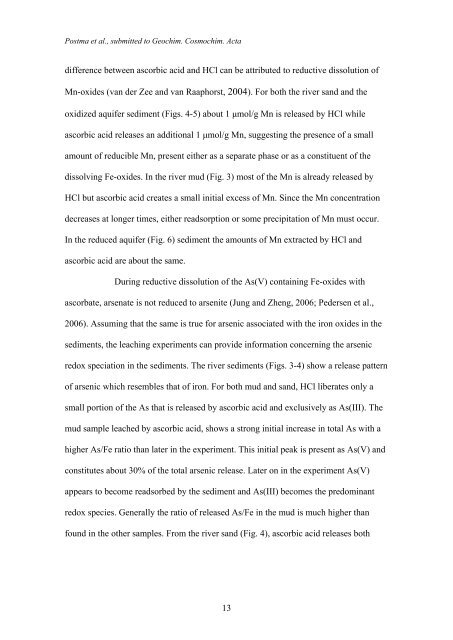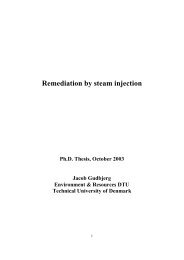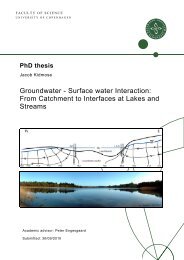Groundwater arsenic in the Red River delta, Vietnam ... - Fiva
Groundwater arsenic in the Red River delta, Vietnam ... - Fiva
Groundwater arsenic in the Red River delta, Vietnam ... - Fiva
You also want an ePaper? Increase the reach of your titles
YUMPU automatically turns print PDFs into web optimized ePapers that Google loves.
Postma et al., submitted to Geochim. Cosmochim. Acta<br />
difference between ascorbic acid and HCl can be attributed to reductive dissolution of<br />
Mn-oxides (van der Zee and van Raaphorst, 2004). For both <strong>the</strong> river sand and <strong>the</strong><br />
oxidized aquifer sediment (Figs. 4-5) about 1 mol/g Mn is released by HCl while<br />
ascorbic acid releases an additional 1 mol/g Mn, suggest<strong>in</strong>g <strong>the</strong> presence of a small<br />
amount of reducible Mn, present ei<strong>the</strong>r as a separate phase or as a constituent of <strong>the</strong><br />
dissolv<strong>in</strong>g Fe-oxides. In <strong>the</strong> river mud (Fig. 3) most of <strong>the</strong> Mn is already released by<br />
HCl but ascorbic acid creates a small <strong>in</strong>itial excess of Mn. S<strong>in</strong>ce <strong>the</strong> Mn concentration<br />
decreases at longer times, ei<strong>the</strong>r readsorption or some precipitation of Mn must occur.<br />
In <strong>the</strong> reduced aquifer (Fig. 6) sediment <strong>the</strong> amounts of Mn extracted by HCl and<br />
ascorbic acid are about <strong>the</strong> same.<br />
Dur<strong>in</strong>g reductive dissolution of <strong>the</strong> As(V) conta<strong>in</strong><strong>in</strong>g Fe-oxides with<br />
ascorbate, arsenate is not reduced to arsenite (Jung and Zheng, 2006; Pedersen et al.,<br />
2006). Assum<strong>in</strong>g that <strong>the</strong> same is true for <strong>arsenic</strong> associated with <strong>the</strong> iron oxides <strong>in</strong> <strong>the</strong><br />
sediments, <strong>the</strong> leach<strong>in</strong>g experiments can provide <strong>in</strong>formation concern<strong>in</strong>g <strong>the</strong> <strong>arsenic</strong><br />
redox speciation <strong>in</strong> <strong>the</strong> sediments. The river sediments (Figs. 3-4) show a release pattern<br />
of <strong>arsenic</strong> which resembles that of iron. For both mud and sand, HCl liberates only a<br />
small portion of <strong>the</strong> As that is released by ascorbic acid and exclusively as As(III). The<br />
mud sample leached by ascorbic acid, shows a strong <strong>in</strong>itial <strong>in</strong>crease <strong>in</strong> total As with a<br />
higher As/Fe ratio than later <strong>in</strong> <strong>the</strong> experiment. This <strong>in</strong>itial peak is present as As(V) and<br />
constitutes about 30% of <strong>the</strong> total <strong>arsenic</strong> release. Later on <strong>in</strong> <strong>the</strong> experiment As(V)<br />
appears to become readsorbed by <strong>the</strong> sediment and As(III) becomes <strong>the</strong> predom<strong>in</strong>ant<br />
redox species. Generally <strong>the</strong> ratio of released As/Fe <strong>in</strong> <strong>the</strong> mud is much higher than<br />
found <strong>in</strong> <strong>the</strong> o<strong>the</strong>r samples. From <strong>the</strong> river sand (Fig. 4), ascorbic acid releases both<br />
13





